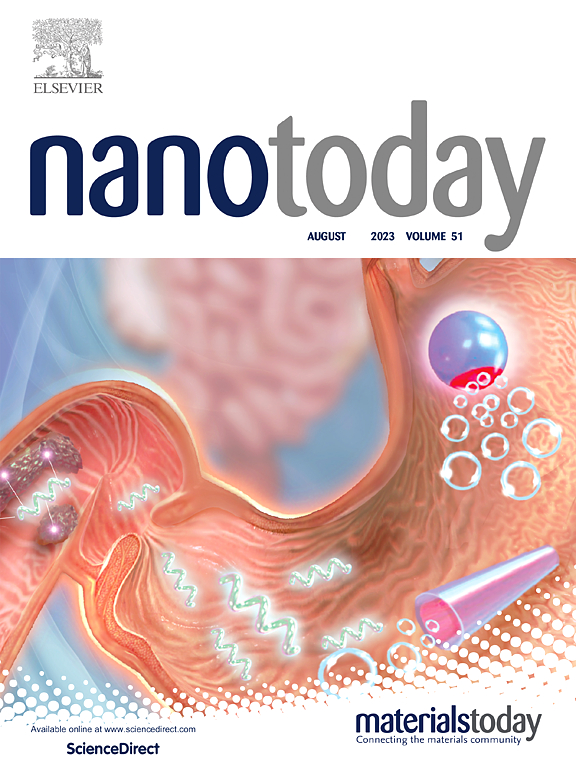光热免疫治疗用聚乙烯醇吡咯烷酮和乙二醇修饰Cu2SnS3 (PE/CTS)纳米材料的一锅溶剂热合成
IF 10.9
1区 材料科学
Q1 CHEMISTRY, MULTIDISCIPLINARY
引用次数: 0
摘要
光热疗法(PTT)不仅能消融肿瘤组织,还能通过增强免疫原性来激活抗肿瘤免疫,这在很大程度上依赖于具有优异光热效应的光热纳米剂(PTNAs)。本文采用一锅溶剂热法合成了具有良好生物相容性和稳定性的聚乙烯吡咯烷酮(PVP)和乙二醇(EG)修饰的Cu2SnS3 (PE/CTS)纳米颗粒(NPs)和纳米片(NSs),并将其应用于光热免疫治疗。PE/CTS NPs和NSs具有较强的近红外吸收和较高的消光系数,光热转换效率(PCE)分别为39.3 %和46.8 %。此外,PE/CTS NPs在NIR-I区的光热效应优于NSs,这主要是由于PE/CTS NPs的血液循环时间更长,肿瘤蓄积增强,肿瘤细胞对NPs的摄取水平更高。因此,PE/CTS nps介导的PTT可有效抑制小鼠4T1异种移植肿瘤的生长。此外,它通过诱导树突状细胞(dc)成熟,随后激活、增殖和肿瘤内T淋巴细胞浸润来增强局部/全身免疫反应,并通过促进m1表型巨噬细胞的产生和调节性T细胞(Tregs)的减少来减轻免疫抑制。因此,PE/CTS nps介导的PTT明显抑制远处肿瘤的生长。本研究突出了基于cts的纳米材料在光热免疫治疗中的潜力,拓宽了三元金属硫族纳米材料的医学应用范围。本文章由计算机程序翻译,如有差异,请以英文原文为准。
One-pot solvothermal synthesis of polyvinyl pyrrolidone and ethylene glycol-modified Cu2SnS3 (PE/CTS) nanomaterials for photothermal immunotherapy
Photothermal therapy (PTT) not only ablates tumor tissues, but also activates antitumor immunity by enhancing immunogenicity, which highly relies on photothermal nanoagents (PTNAs) with excellent photothermal effect. Herein, polyvinyl pyrrolidone (PVP) and ethylene glycol (EG)-modified Cu2SnS3 (PE/CTS) nanoparticles (NPs) and nanosheets (NSs) with excellent biocompatibility and stability were synthesized via the one-pot solvothermal method and applied for photothermal immunotherapy. Because of their strong near-infrared (NIR) light absorption and high extinction coefficient, PE/CTS NPs and NSs possessed high photothermal conversion efficiency (PCE) of 39.3 % and 46.8 %, respectively. Furthermore, the superior photothermal effect of PE/CTS NPs over NSs in the NIR-I region was confirmed both in vitro and in vivo, mainly because of the longer blood circulation time, enhanced tumor accumulation, and higher tumor cell uptake level of NPs. As thus, PE/CTS NPs-mediated PTT effectively inhibited growth of 4T1 xenograft tumors in mice. Moreover, it enhanced local/systemic immune responses by inducing the maturation of dendritic cells (DCs) followed by the activation, proliferation, and intratumoral infiltration of T lymphocytes, and it alleviated immunosuppression by promoting the production of M1-phenotype macrophages and the reduction of regulatory T cells (Tregs). Consequently, PE/CTS NPs-mediated PTT notably inhibited the growth of distant tumors. This study highlights the potential of CTS-based nanomaterials for photothermal immunotherapy, broadening the scope of medical applications of ternary metal chalcogenide nanomaterials.
求助全文
通过发布文献求助,成功后即可免费获取论文全文。
去求助
来源期刊

Nano Today
工程技术-材料科学:综合
CiteScore
21.50
自引率
3.40%
发文量
305
审稿时长
40 days
期刊介绍:
Nano Today is a journal dedicated to publishing influential and innovative work in the field of nanoscience and technology. It covers a wide range of subject areas including biomaterials, materials chemistry, materials science, chemistry, bioengineering, biochemistry, genetics and molecular biology, engineering, and nanotechnology. The journal considers articles that inform readers about the latest research, breakthroughs, and topical issues in these fields. It provides comprehensive coverage through a mixture of peer-reviewed articles, research news, and information on key developments. Nano Today is abstracted and indexed in Science Citation Index, Ei Compendex, Embase, Scopus, and INSPEC.
 求助内容:
求助内容: 应助结果提醒方式:
应助结果提醒方式:


